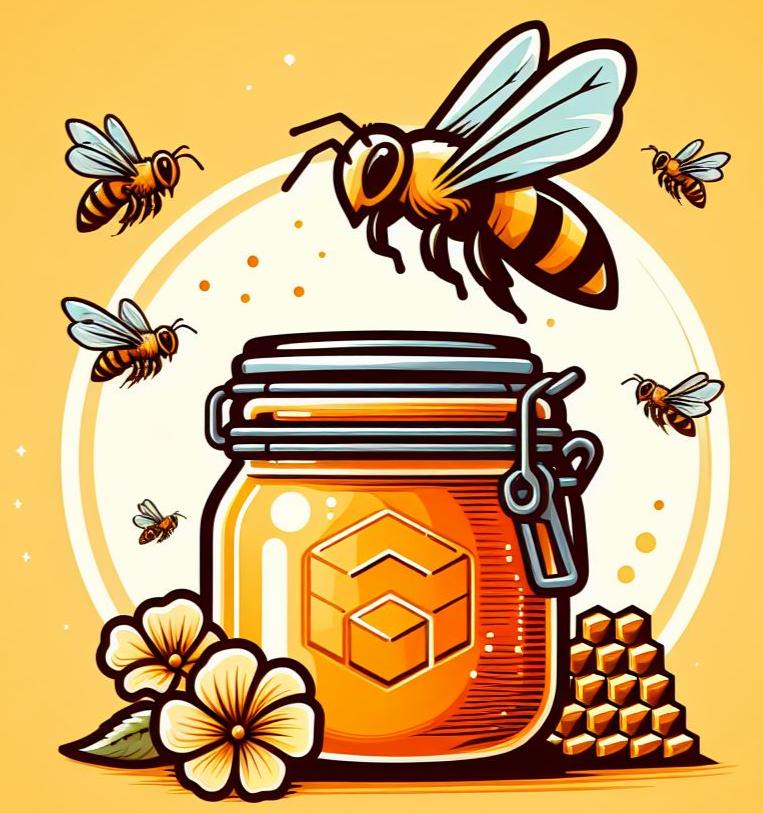Ghee butter with propolis might seem like an unlikely pair, but together they form a nutritional powerhouse. Bringing together the nourishing richness of ghee and the natural protective properties of propolis, this combo is about enhancing wellness in a truly holistic way.
Why Bring Propolis and Ghee Together?
The fusion of ghee and propolis is about amplifying their health benefits.
Ghee acts as a perfect carrier for the bioactive compounds in propolis, making them more accessible to the body.
This blend not only supports digestive health and immunity boosts but also serves as a formidable force against inflammation and oxidative stress.
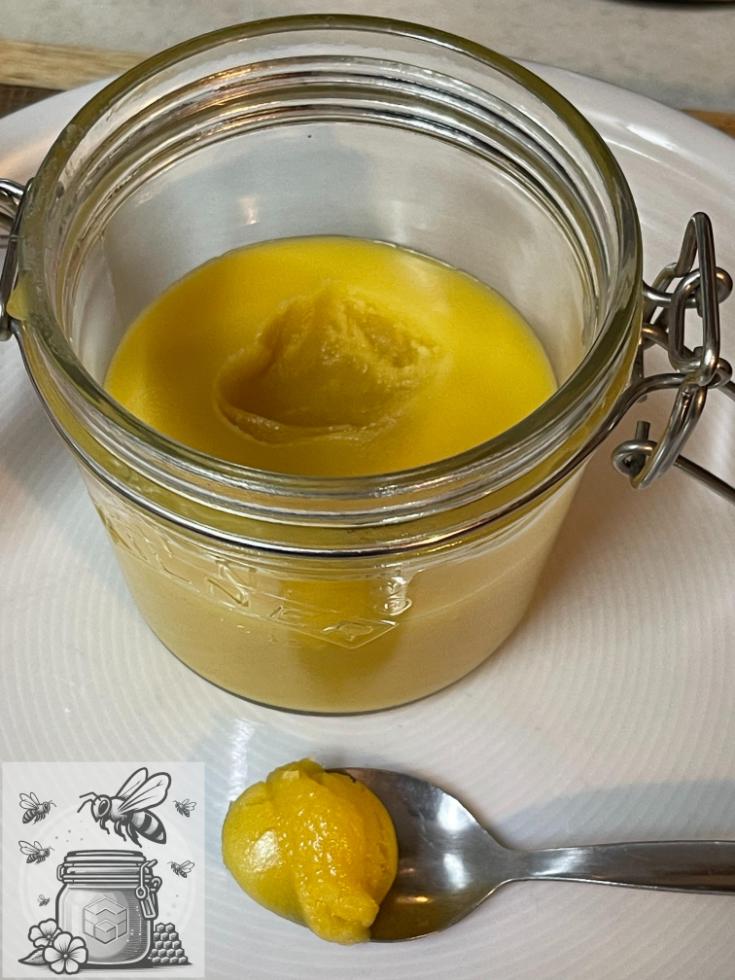
With the aim of enhancing vitality, this blend is worth understanding and trying out for those keen on natural and effective health solutions. You’re not just getting the goodness from two powerful ingredients, but a wholesome addition to your healthy lifestyle.
The best thing — it is quite easy to make. You can start by making your own ghee — below you will find a detailed step-by-step recipe and a wealth of information about ghee butter: its origins, benefits, usage and reference to research.
I. Creating the Perfect Ghee Butter with Propolis: Step-by-Step Guide
Making your own propolis ghee butter at home is not only rewarding but also ensures that you know exactly what’s going into your body. Having control over the quality of your ingredients can significantly enhance the benefits of this natural blend.
Materials Needed for ~15% Propolis Extract in Ghee Butter
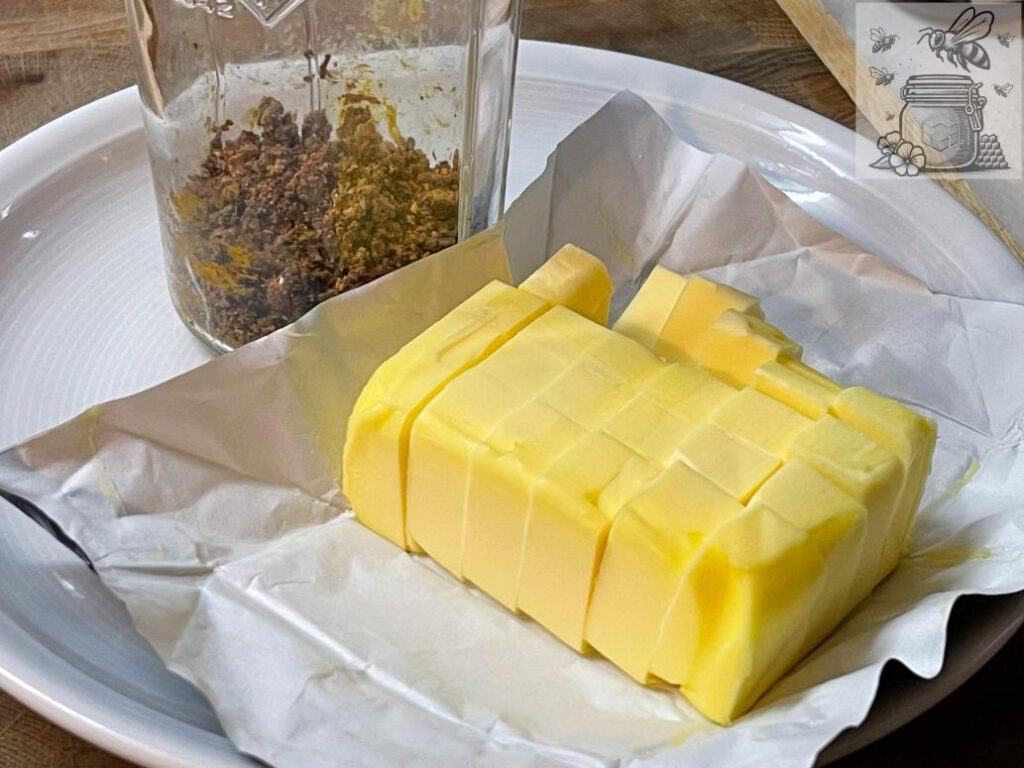
- High-quality unsalted butter
- High-quality propolis
For example, we use 200 grams of butter (it will turn into approximately 150 grams of ghee) and 23 – 27 grams of propolis.
Equipment Needed
- Pot
- Heat-Resistant Glass Jar with a Lid
- Mug (or any container into which to strain the ghee)
- Small Towel
- Slotted/ Skimming Spoon
- Glass Jar with Lid (for storage)
- Stainless Steel Grater (if your propolis is ready to use and is in the shape of rolls or balls)
- Cheesecloth and/or Fine Mesh Strainer
- (Electronic) Scales
- Wooden skewer (for stirring propolis and ghee mix)
- Kitchen thermometer and some paper towel
Step # 1. Prepare Propolis
If you have purchased a good quality propolis, you need to freeze it for at least a couple of hours, and then grate the required quantity and put it in a heat-resistant glass jar.
TIP: If your propolis has too many impurities (wax, wood and bees pieces, dust, etc), we would recommend cleaning it first.
After cleaning freeze and crush the propolis: place the propolis in the freezer for at least a couple of hours to make it brittle. Then, put it in a piece of cheesecloth and crush it into fine bits using a kitchen hammer. This increases the surface area, making it easier to infuse the ghee. (You can also read about this step in our PROPOLIS OIL RECIPE.)
Put the jar with crushed/ grated propolis aside.
Step # 2. Make Your Own Ghee
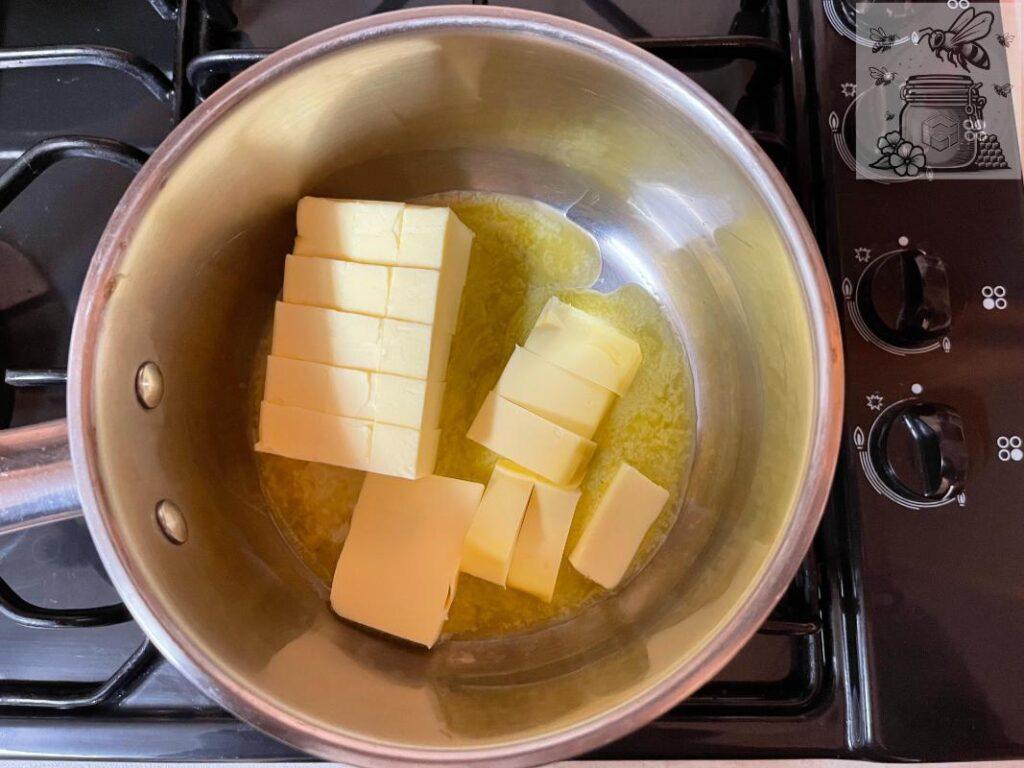
Cut the butter into cubes, put them in a saucepan and gently melt over low heat.
It will start melting and gently bubbling with white foam appearing on the surface.
Start removing it with a skimming spoon into a small bowl.
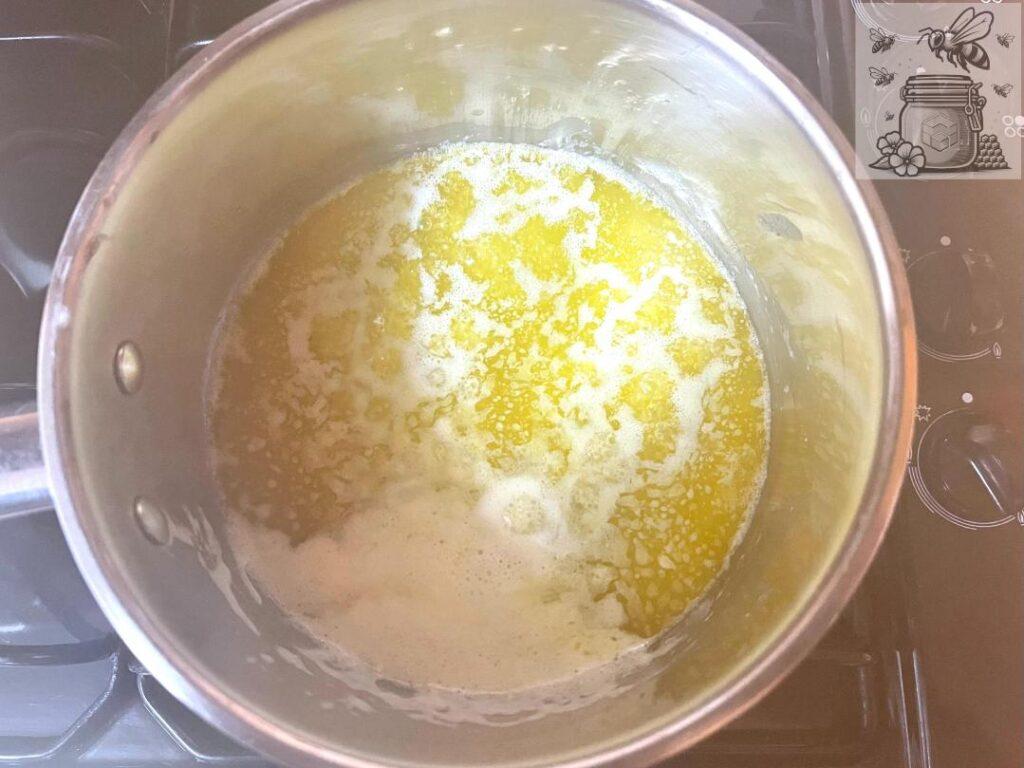
You will see 3 layers:
1) the white stuff that you are removing,
2) opaque liquid under it,
3) some white particles at the bottom (you will see them when after bubbling for a few minutes, the liquid turns transparently golden).
What happens during this time? The water content evaporates, and the milk solids start to separate and settle at the bottom of the pan.
Important!
Do not overheat. If the white particles on the bottom turn brown, your ghee will get a different taste.
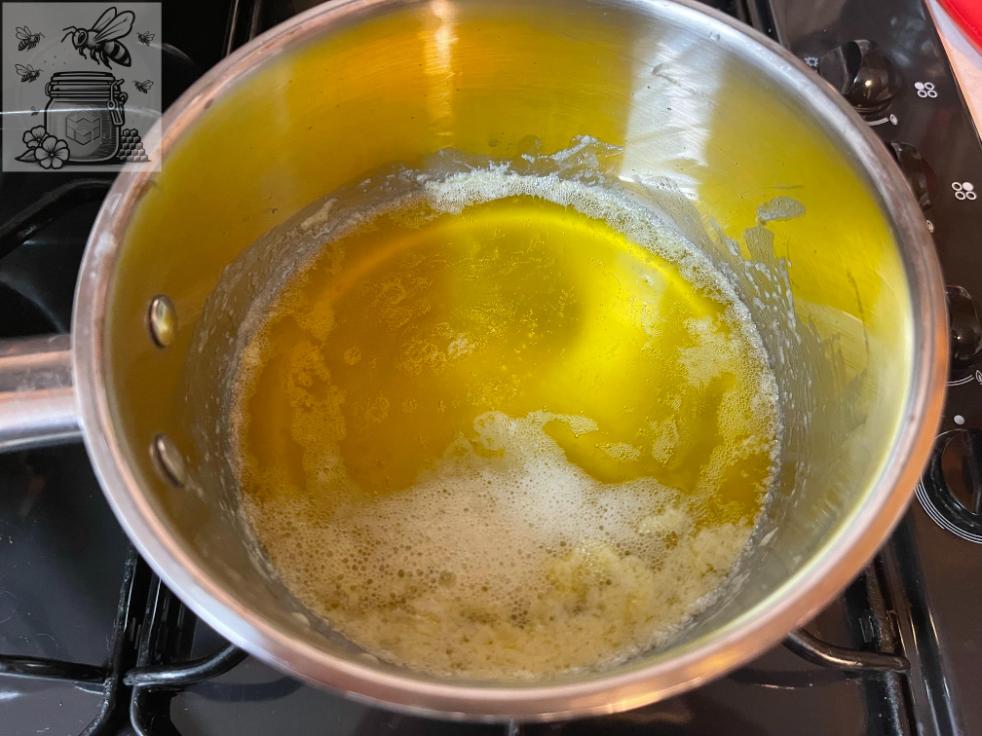
To avoid it, keep an eye and when you see the liquid has become clear and the particles on the bottom are still white (the temperature at this point will be approximately 115°C (239°F).
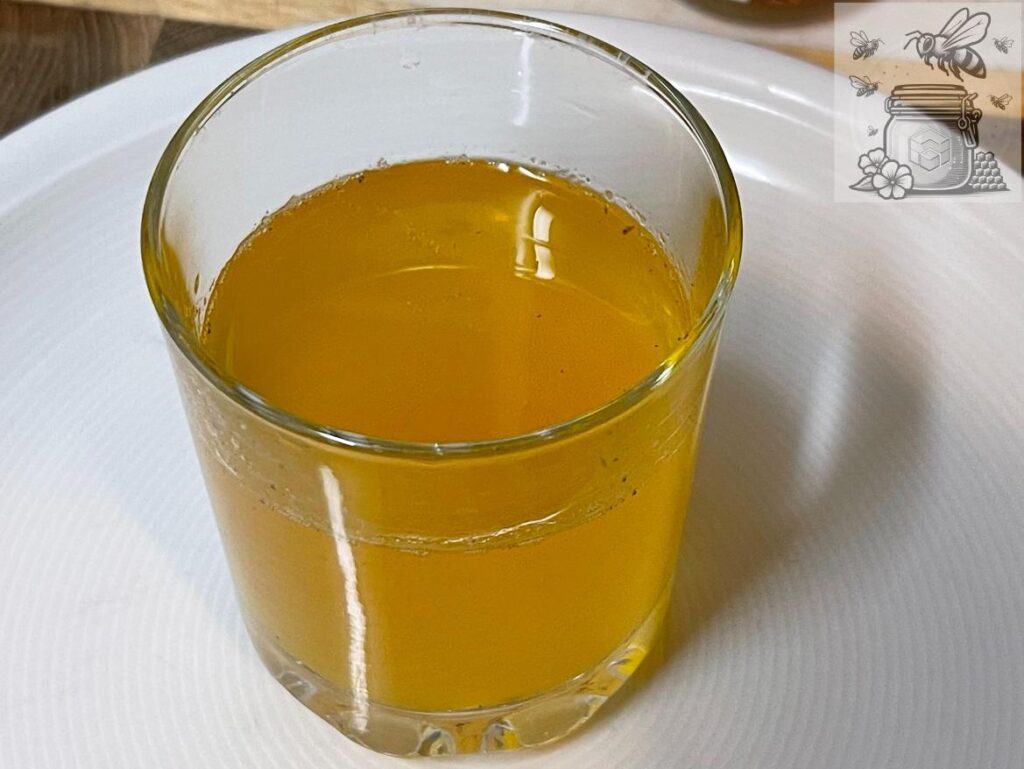
Let the freshly made ghee cool till about 50°C (122°F). We recommend not to exceed this temperature when using propolis.
Step # 3. Infuse Ghee Butter with Propolis
Pour the cooled ghee into the heat-resistant jar with propolis.
Put it into a pot filled with warm water on a small towel (to avoid direct heat to the bottom of the jar).
Keep the heat low. It will take about 15-20 minutes for the water to gradually reach 50°C (122°F). The ghee in the jar will be about a couple degrees less.
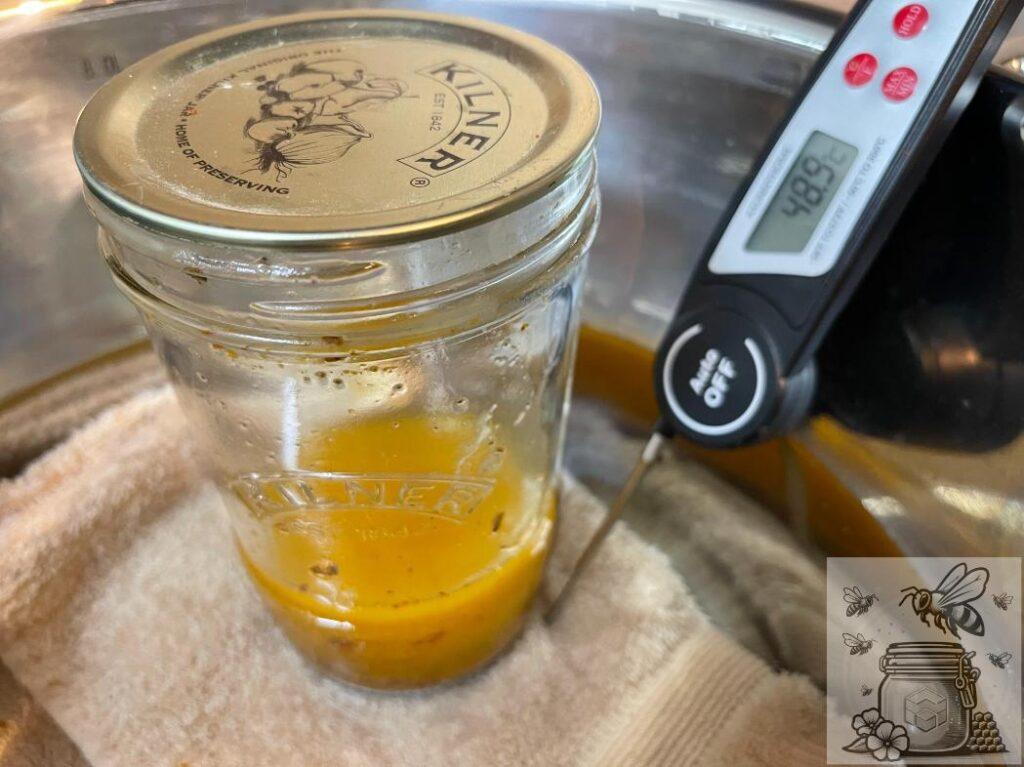
Use the kitchen thermometer regularly. You can check both the water and the ghee in the jar.
TIP: wipe the thermometer each time not to bring water into the ghee.
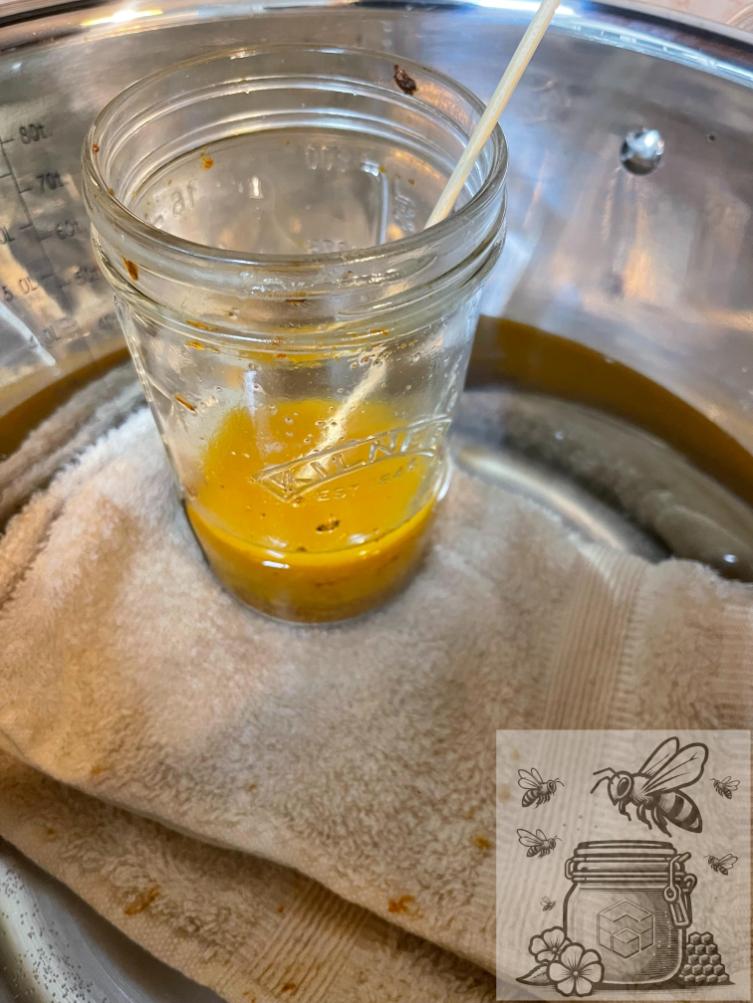
Continue warming the mixture over low heat, keeping the temperature below 50°C (122°F) for at least 2 hours to allow sufficient propolis extraction time.
Stir the mixture every 30 minutes with a skewer.
Step # 4: Strain the Mixture
After the infusion period, remove the mixture from the heat. The beneficial components of propolis has now been extracted into the ghee butter. All is left is to separate the sediment.
Strain the mixture into a clean sterilised jar with a lid. As an option, you can sterilise it by wiping with alcohol.
Use a cheesecloth or/and fine mesh strainer.
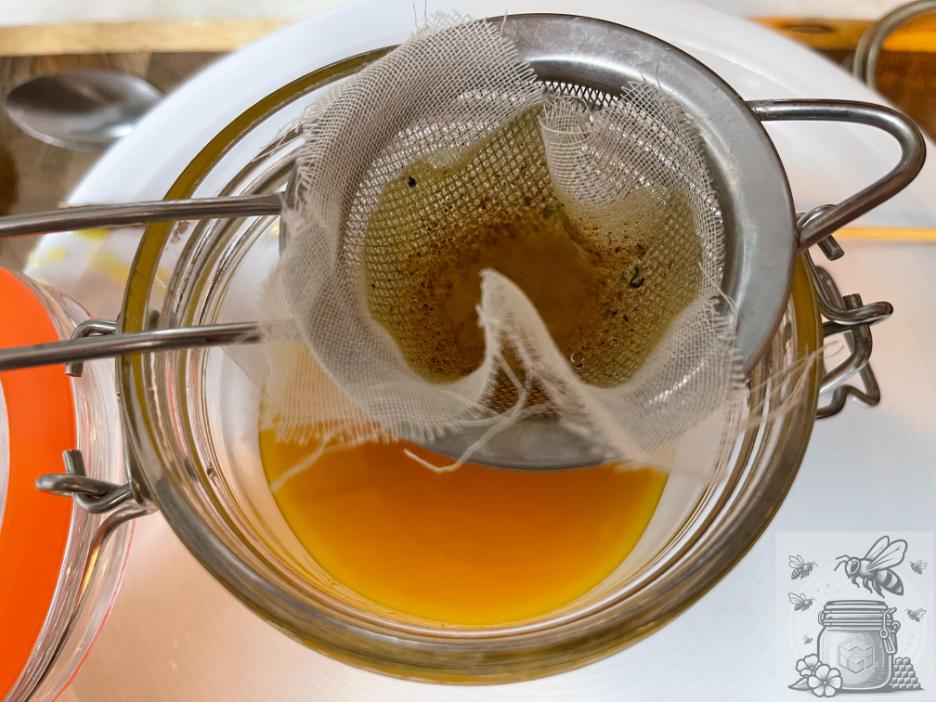
The ghee with propolis is ready. It does not even need to stay in the fridge, if used within 6 months.
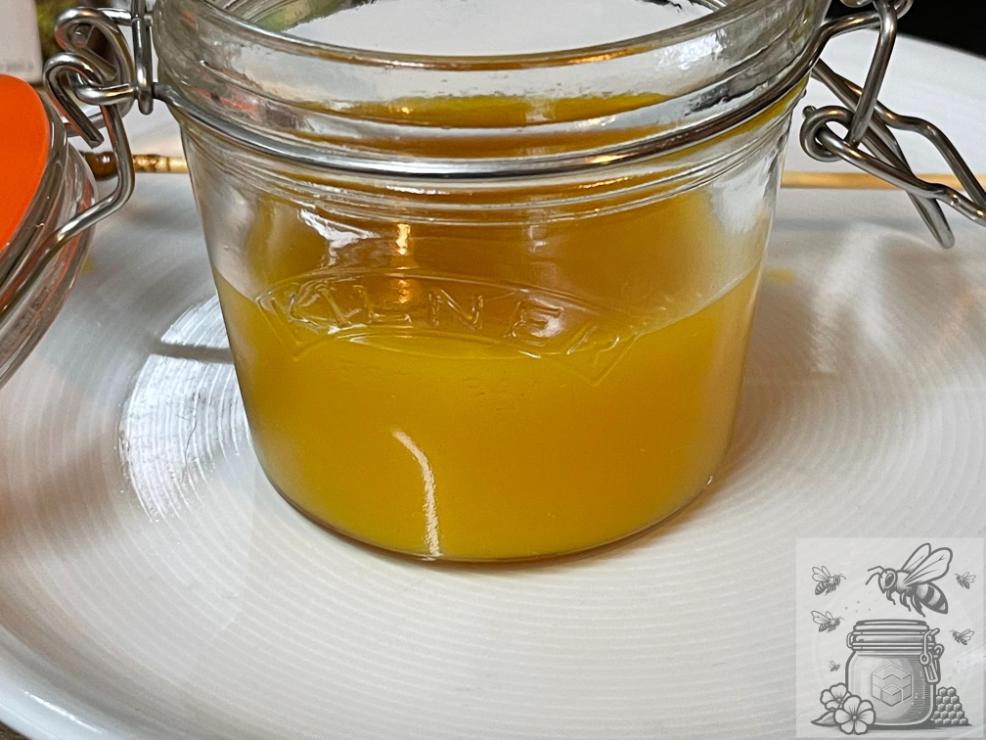
Just keep it in a cool, dark place to preserve the propolis’ active compounds.
In the refrigerator it can last for up to 1 year.
II. Why You Should Use It: Benefits of Ghee Butter with Propolis
The synergy of ghee and propolis offers an impressive arsenal for boosting health. Each ingredient plays its part, and together, they pack a punch that targets several health aspects all at once.
Improved Digestion and Gut Health
Ghee is known to support healthy digestion, promoting a smooth operation of the digestive tract thanks to its butyric acid content. This fatty acid nourishes the cells lining your guts, creating a healthier gut environment. A teaspoonful of ghee butter with propolis can be added to a glass of warm milk (any) — enjoy it before going to bed.
Strengthening Immunity
Propolis shines with its renowned antimicrobial properties, acting as nature’s antibiotic. This may help fend off minor infections and support overall immune health, especially when consumed regularly with ghee, which can optimise its absorption.
Anti-inflammatory Properties
Joint issues and inflammation are common troubles that many face, and that’s where this blend becomes particularly useful. Both ghee and propolis carry anti-inflammatory properties. Together, they may help in reducing inflammation, potentially easing symptoms of arthritis and similar conditions.
Skin and Hair
Ghee is a traditional favorite for glowing skin and healthy hair, providing a natural source of fatty acids and hydration. Combined with propolis, known for its healing and antimicrobial attributes, it becomes a potent combination for topical application, fighting skin irritations and promoting healthy hair growth.
The effectiveness of propolis ghee butter greatly depends on how you incorporate it into your daily routine.
General Wellness and Immune Support
A teaspoon daily is a good start. You can adjust the amount based on your individual needs and health goals. Some prefer incorporating it into their morning routine, adding a small spoonful to their tea or coffee for a nourishing kickstart to the day.
Enhancing your meals with propolis ghee is another practical approach. Spread it on toast, swirl it into soups, or use it with cooked vegetables.
Also, consider its external applications for skin. A small amount rubbed into the skin can support hydration and fight inflammation.
It can be used as a hair mask, applied from roots to tips to promote strength and shine.
Be Mindful of Individual Reactions
Start with small quantities to assess tolerance, particularly for those new to propolis. Consult with a healthcare provider if you’re pregnant, breastfeeding, or have any underlying health conditions before making it a regular part of your diet.
Overall, propolis ghee butter offers a range of health benefits worth exploring, balancing practicality with the deep-seated benefits of ghee and propolis. As more people seek natural solutions, this powerful blend is a testament to the time-tested wisdom of traditional practices.
III. What Is Ghee Butter and Why Is It a Good Combination with Propolis
Ghee, also known as clarified butter, has a rich history stemming from ancient India. Used as a staple in Ayurvedic medicine, it’s known for its rich, buttery taste, impressive nutritional profile and long shelf life. Packed with healthy fats, vitamins, and antioxidants, ghee doesn’t just add flavour — it helps support brain health, digestion, and immunity.
Ghee is a traditional cooking fat that has been used for thousands of years, particularly in Indian, Pakistani, and Middle Eastern cuisines. Recently it has gained global popularity due to its health benefits and versatility in cooking.
History of Ghee
Ghee has its origins in ancient India, where it has been used for over 5,000 years. In Hindu culture, ghee is considered sacred and is used in religious rituals, traditional medicine (Ayurveda), and cooking. The word “ghee” is derived from the Sanskrit word “ghrita,” meaning “sprinkled” or “poured.”
Cultural Importance
- India: ghee is an integral part of Indian cuisine and rituals. It is used in offerings during religious ceremonies, known as “yajnas,” where ghee is poured into sacred fires.
- Ayurveda: in Ayurvedic medicine, ghee is considered a healing food. It is used to enhance digestion, improve skin health, and as a carrier (anupana) for delivering herbal remedies.
- Other Regions: ghee is also widely used in Pakistan, Nepal, Sri Lanka, and the Middle East, where it is referred to as Samna in Arabic cuisine.
Where is Ghee Used?
Ghee is a versatile cooking fat used in various types of cuisine and recipes, particularly in:
Indian Cooking
Ghee is a key ingredient in dishes like curries, dals, rotis (Indian flatbread), and rice. It’s also used for frying and sautéing.
Middle Eastern and African Cuisine
Ghee is used in traditional dishes like Biryani, Kabsa, and in the preparation of Meat Stews.
Western Cuisine
Due to its high smoke point (around 485°F/250°C), ghee is gaining popularity for high-heat cooking, such as frying and roasting, and as a replacement for butter in baking.
Religious and Medicinal Practices
Ghee is used in Ayurveda for medicinal purposes, skin care, and as a carrier for herbs.
Health Benefits of Ghee
Ghee is celebrated for its multiple health benefits, which make it a popular choice for cooking, medicinal use, and skin care.
Rich in Healthy Fats
Ghee is high in saturated fats, which are stable at high temperatures and beneficial for those following high-fat diets like ketogenic or paleo diets.
It contains medium-chain fatty acids (MCFAs), including butyrate, a fatty acid beneficial for gut health and digestion.
Lactose-Free and Casein-Free
During the ghee-making process, milk solids (which contain lactose and casein) are removed, making ghee suitable for people who are lactose or casein intolerant.
Rich in Fat-Soluble Vitamins
Ghee is a good source of vitamins A, D, E, and K, which are essential for immunity, bone health, and skin vitality.
Promotes Digestive Health
Butyric acid, present in ghee, supports gut health by promoting the growth of healthy gut bacteria and reducing inflammation in the digestive tract.
Boosts Immunity
In Ayurveda, ghee is known to boost the Ojas, the vital essence that strengthens immunity and overall vitality.
Good for Cooking at High Temperatures
Ghee has a high smoke point of 485°F (250°C), making it an excellent option for high-heat cooking without breaking down into harmful free radicals.
Skin Health
Applied topically, ghee is known to deeply moisturise and repair dry or damaged skin, and it is often used in Ayurvedic skin treatments.
Why is Ghee Popular?
Ghee has gained popularity worldwide, especially in health-conscious circles, for the following reasons:
- Health Trends: as interest in keto and paleo diets has increased, ghee’s reputation as a healthy fat with multiple benefits has boosted its popularity.
- Lactose-Free: many people with lactose intolerance or dairy allergies opt for ghee because the lactose and casein are removed during the clarification process.
- Ayurveda and Wellness: with the rise in interest in Ayurvedic practices and natural wellness, ghee has become a staple in many wellness routines for both consumption and topical use.
- Versatility: ghee’s ability to be used in a wide range of cooking techniques, from sautéing to deep frying, makes it a valuable addition to kitchens worldwide.
- Long Shelf Life: unlike traditional butter, ghee can be stored without refrigeration and lasts for a long time without going rancid.
Comparison with Traditional Butter
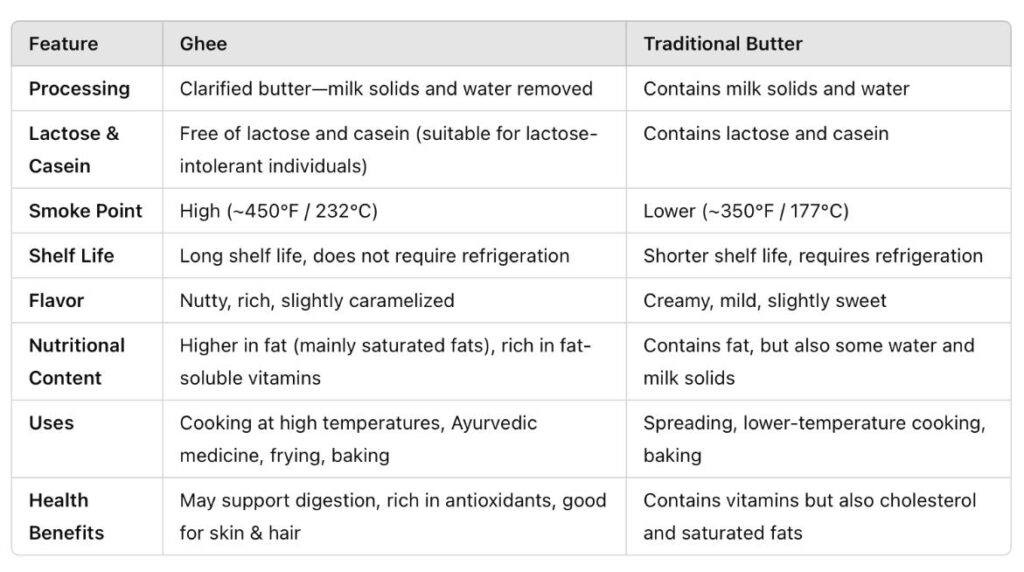
Storage
One of the great advantages of ghee is its long shelf life.
Storage Tips
- Room Temperature: ghee can be stored at room temperature in an airtight container for up to 6 months. Keep it away from direct sunlight and moisture.
- Refrigeration: to extend its shelf life, ghee can be refrigerated, where it can last for up to a year. Refrigerated ghee may harden, but it will soften at room temperature.
- Freezing: ghee can also be stored in the freezer, where it can last for up to 2 years. Be sure to store it in a freezer-safe container to prevent freezer burn.
Signs of Spoilage
- Ghee has a long shelf life, but it can spoil if exposed to moisture or contaminants. Signs of spoilage include a sour smell, changes in texture, or visible mold. Spoiled ghee should be discarded.
Summary
Ghee is a versatile, nutrient-dense fat that has been a part of traditional cooking and medicinal practices for thousands of years. Its rich flavour, health benefits, and long shelf life make it a preferred choice for many. Whether you’re following a specific diet like keto or paleo, or simply looking for a healthier, more stable alternative to butter, ghee offers numerous advantages, including higher heat stability, greater nutrient concentration, and suitability for lactose-intolerant individuals.
Research
Several scientific studies have examined ghee and its potential health benefits, nutritional profile, and impacts on human health. Research has focused on its use in cooking, its effects on cholesterol, and its role in traditional medicine, particularly in Ayurveda. Below are some examples:
1. Ghee and Cardiovascular Health
Study: “Effect of ghee (clarified butter) on lipid profiles in Indian adults”
- Published in: Journal of Clinical Biochemistry and Nutrition (2010)
- Authors: Shankar P. G., Agrawal A. K., Chakravarty S., et al.
Findings
- This study investigated the effect of ghee on lipid profiles in healthy individuals and those with cardiovascular disease.
- Results: Consumption of moderate amounts of ghee did not significantly elevate cholesterol levels in healthy individuals. In some cases, it improved the ratio of high-density lipoprotein (HDL) to low-density lipoprotein (LDL) cholesterol.
- Conclusion: While high consumption of saturated fats is often linked to elevated cholesterol, ghee consumed in moderation may have a neutral or even beneficial effect on lipid profiles.
2. Ghee and Gut Health
Study: “Short-chain fatty acids, particularly butyrate, improve intestinal barrier function”
- Published in: Clinical Nutrition (2014)
- Authors: Canani R. B., Costanzo M., Leone L., et al.
Findings
- Ghee contains butyrate, a short-chain fatty acid (SCFA) that has been shown to improve gut health by supporting the intestinal barrier function, reducing inflammation, and promoting the health of colon cells.
- Results: Butyrate has anti-inflammatory effects and can benefit conditions like irritable bowel syndrome (IBS) and inflammatory bowel disease (IBD). Ghee, being a good source of butyrate, may help in gut health and support digestion.
3. Antioxidant and Nutritional Properties of Ghee
Study: “Nutritional and biological value of ghee (clarified butter) – A review”
- Published in: International Journal of Dairy Technology (2006)
- Authors: G. Sharma, S. Singh
Findings
- Ghee is rich in fat-soluble vitamins, particularly vitamin A, vitamin D, vitamin E, and vitamin K. These vitamins are essential for maintaining skin, eye, bone, and immune system health.
- Ghee also contains antioxidants that protect cells from oxidative stress and prevent lipid peroxidation, a process that leads to cell damage.
4. Ghee’s Role in Ayurveda and Anti-Inflammatory Effects
Study: “Ayurvedic ghee-based lipid formulations: Therapeutic and nutraceutical importance”
- Published in: Journal of Ethnopharmacology (2011)
- Authors: Achliya G. S., Wadodkar S. G., Dorle A. K.
Findings
- In Ayurveda, ghee is considered a powerful substance for balancing Pitta and Vata doshas, promoting longevity, and improving digestive health.
- Ghee-based formulations in Ayurveda are used to deliver herbal remedies, improving absorption and enhancing the therapeutic effects of the herbs.
- Anti-inflammatory Properties: Ghee has been used to treat burns and wounds due to its anti-inflammatory and antimicrobial properties.
5. Ghee and Cooking Stability
Study: “Comparative stability of ghee and other cooking oils during frying”
- Published in: Food Chemistry (2014)
- Authors: Nayik G. A., Dar S. M., Nanda V.
Findings
- Ghee has a higher smoke point (around 250°C/485°F) than many other cooking oils, making it suitable for high-temperature cooking, such as frying or roasting.
- Results: Ghee is more stable than vegetable oils during high-temperature cooking, as it does not break down into harmful free radicals as quickly. This stability reduces the formation of acrylamide and other harmful compounds linked to oxidation of fats.
